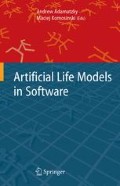Access this chapter
Tax calculation will be finalised at checkout
Purchases are for personal use only
Preview
Unable to display preview. Download preview PDF.
References
Adamatzky A (1994) Identification of Cellular Automata. Taylor and Francis, London.
Conway JH (1982) What Is Life? In: Winning ways for your mathematical plays, Berlekamp E, Conway JH and Guy R (eds.). Academic Press, New York.
Harris ES, Sawhill BK, Wuensche A, and Kauffman S (1997) Biased eukaryotic gene regulation rules suggest genome behavior is near edge of chaos. Santa Fe Institute Working Paper 97-05-039.
Kauffman SA (1993) The Origins of Order. Oxford University Press.
Langton CG (1990) Computation at the edge of chaos: phase transitions and emergent computation. Physica D 42:12–37.
Somogyi R and Sniegoski C (1996) Modeling the complexity of genetic networks. Complexity 1:45–63.
Wolfram S (ed) (1986) Theory and Application of Cellular Automata. World Scientific.
Wuensche A and Lesser MJ (1992) The Global Dynamics of Cellular Automata. Addison-Wesley, Reading, MA.
Wuensche A (1994) The ghost in the machine: Basin of attraction fields of random Boolean networks. In: Artificial Life III, Langton CG (ed.). Addison-Wesley, Reading, MA.
Wuensche A (1994) The emergence of memory. In: Towards a Science of Consciousness. Hameroff SR, Kaszniak AW and Scott AC (eds.). MIT Press.
Wuensche A (1997) Attractor basins of discrete networks: Implications on self-organisation and memory. Cognitive Science Research Paper 461., D. Phil Thesis, University of Sussex.
Wuensche A (1998) Genomic regulation modeled as a network with basins of attraction. In: Proc. 1998 Pacific Symposium on Biocomputing. World Scientific, Singapore.
Wuensche A (1999) Classifying cellular automata automatically: Finding gliders, filtering, and relating space-time patterns, attractor basins, and the Z parameter. Complexity 4:47–66.
Wuensche A (2001) The DDLab Manual, PDF available at www.ddlab.org.
Wuensche A (2003) Discrete Dynamics Lab: Tools for investigating cellular automata and discrete dynamical networks. Kybernetes 32.
Wuensche A (2004) Self-reproduction by glider collisions: The beehive rule. In: Proc. Alife9, J. Pollack et al. (eds.), 286–291. MIT Press.
Editor information
Editors and Affiliations
Rights and permissions
Copyright information
© 2005 Springer-Verlag London Limited
About this chapter
Cite this chapter
Wuensche, A. (2005). Discrete Dynamics Lab: Tools for Investigating Cellular Automata and Discrete Dynamical Networks. In: Adamatzky, A., Komosinski, M. (eds) Artificial Life Models in Software. Springer, London. https://doi.org/10.1007/1-84628-214-4_11
Download citation
DOI: https://doi.org/10.1007/1-84628-214-4_11
Publisher Name: Springer, London
Print ISBN: 978-1-85233-945-6
Online ISBN: 978-1-84628-214-0
eBook Packages: Computer ScienceComputer Science (R0)

